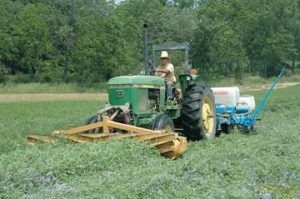It all began in 2002 with a $6,500 SARE grant and the seed of an idea. Today, that idea has grown into hundreds of research projects around the country and a new, effective tool that farmers are using to improve soil quality, weed management and the bottom line.
The tool is the roller crimper, a drum with blades mounted to the front- or back-end of a tractor that is used to roll down, crimp and kill cover crops, creating thick, weed suppressing mulch. Today, the roller crimper is a common sight on land-grant university research plots, according to Jeff Moyer, director of farm operations at the Rodale Institute in Kutztown, Penn., who conceived of the tool and has led in-depth research on its use, including that first grant.
The crimper, while not a fix-all, has shown many advantages, including using 40 percent less energy than cultivating or spraying; reducing erosion; retaining moisture; and allowing for more flexibility, since roll downs do not need to be timed to dry conditions.
Tim Bock, who runs a 100-acre certified organic farm outside Kutztown, has tried the roller on more than 20 acres for another SARE-funded project. After two years of success, he plans to completely switch his soybean production to rolled rye. “The results have been outstanding,” Bock says. “I’ve really reduced my weed pressure and drastically reduced the number of trips across the field. I eliminated a complete tillage cycle.”
This research is only one example of how SARE is at the forefront of supporting the innovative producers, educators and researchers who are making cover crops one of the most indispensable cost-saving tools in the soil-health toolbox. SARE grantees all over the country are discovering the immense benefits of integrating both cover crops and conservation tillage into farming operations. For example:
- On his Montana dryland farm, Jess Alger used a 1999 SARE grant to compare no-till wheat grown with a black medic cover crop to a conventional wheat system. In two years of trials, below-average precipitation led to losses in both systems, but he lost considerably less on the no-till field: a combined $11.46 per acre, as opposed to $75.90 per acre on the conventional field.
- Virginia Tech researcher Ron Morse used a 2003 SARE grant to lay the groundwork in a newly researched area: using no-till and cover crops in organic broccoli and cabbage production. While encountering many challenges, Morse had many encouraging results that have informed subsequent research, including that no-till cabbage yields were 41 percent better than with conventional tillage.
- After being approached by organic farmers interested in adopting no-till, Ohio State University researchers used a 2004 SARE grant to compare soybean yields resulting from various combinations of cover crops and no-till termination methods, including roller crimpers and mowers. The researchers found that no-till could work: There was no significant difference in yields between these no-till treatments and conventional tillage practices.
This only scratches the surface of the hundreds of research and on-farm demonstration projects SARE has supported on cover crops in the last 25 years. To discover more, and to find the practical tools and guides, visit SARE’s Cover Crops Topic Room.



